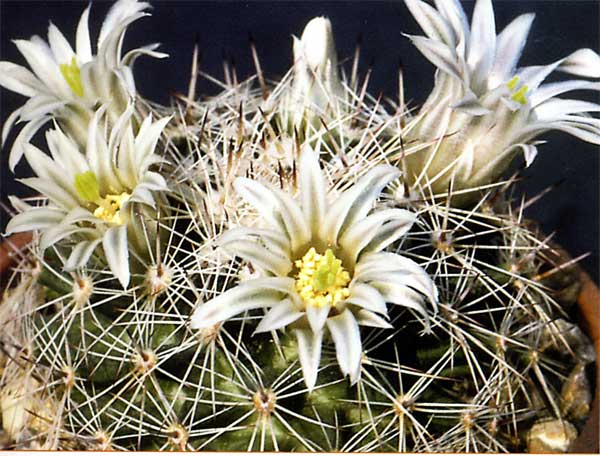
Mammillaria of the Month
(click here for previous Mamms of the Month)
The M. heyderi complex (Part 1)

Photograph by Courtesy of John Pilbeam, reproduced from "Mammillaria" Mammillaria heyderi ssp. heyderi
Mammillaria heyderi, in contrast to some of the species featured here recently, is a well known and frequently collected species. It occurs from well within the southern US States of Texas, New Mexico and Arizona as far south as the Yucatan peninsular. There are 6 subspecies that form the Mammillaria heyderi complex and this month we will feature three of these, with the remaining ones next month.
Mammillaria heyderi ssp. heyderi is widespread, itself being the most common form in the southern US States, but extending down the Eastern states of Mexico well into Veracruz. It has typically 15-22 radial spines and a single central spine with cream flowers, having a greenish or brownish-pink midstripe. The fruiy is red, and the seed reddish brown.
Mammillaria heyderi ssp. gaumeri either jumped a distance across the Gulf of Mexico or was stranded there as a result of substantial geological changes. It comes from the Yucatan pensinsular, as as might therefore be expected, tends to do best in rather warmer temperatures than its cousins. It has typically only 10-12 radial spines, although it has been reported with numbers up to 19, again a single central spine and cream flowers. When well grown it has very woolly areoles, and can be a spectacular plant.
Photograph by Courtesy of John Pilbeam, reproduced from "Mammillaria" Mammillaria heyderi ssp. gaumeri
The third member of the complex that we are looking at this month is Mammillaria heyderi ssp. gummifera.This subspecies is rather darker in spination and flower than its cousins, and is a more westerly occurring species although widespread from Chihuahua down to Jalisco and Zacatecas. This has a similar number of radial spines to the preceding subspecies, but they are typically longer, the lower ones stouter and up to 2.5cm long. It has between 1 and 4 central spines, stronger than the radials. The flowers are rather darker.
Photograph by Courtesy of John Pilbeam, reproduced from "Mammillaria" Mammillaria heyderi ssp. gummifera
All species do well in cultivation, and though they may not be the showiest of the Mammillarias, they are reliable flowerers once they reach a few years old from seed, given good light. A group of the 6 subspecies can be quite dramatic and clearly show the differences in body shape and spination.